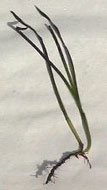| Ninigret Salt Pond |
Physical Characteristics |
| Ninigret Salt Pond |
Physical Characteristics |
Has anything affected the biology of Ninigret Salt Pond besides the increasing human population?The permanent opening of the Charlestown Breachway (see history of breachway) was another very important factor affecting the pond ecosystem. With seawater flowing into the pond, the water in the pond changed from water that had only a small amount of salt in it (brackish) to water that was salty and flushed with each tidal cycle. Although the breachway was made permanent to improve fisheries in the pond, the increased salinity had the opposite effect. Oysters had been abundant in the pond prior to the breachway being stabilized but afterwards the number of oysters declined. The oysters could not withstand the higher salinity, increased tidal flushing, or higher number of predators that the breachway brought. Oysters still grow in the coves where fresh water enters from streams and springs. The scallop population once plentiful is no longer commercially sustainable. The white perch, smelt, and alewife fisheries were lost after the breachway remained open year round.



The Charlestown Breachway caused other changes in the biota of Ninigret Pond. Prior to the breachway becoming permanent the dominant vegetation in the pond was widgeon grass, a type of submerged aquatic vegetation. Widgeon grass grows in brackish water but has no tolerance for salt water. Less thick eelgrass beds replaced the dense beds of widgeon grass. This may not seem like an important difference but migratory waterfowl (ducks and geese) prefer to eat widgeon grass. The muskrat is another member of the pond's biota that was lost because of the breachways. Muskrats were plentiful and trapping them provided an income for a number of people in the winter. Muskrats depended on cattail marshes and the constant water level that characterized the pond before the breachway and couldn't survive the change in conditions.